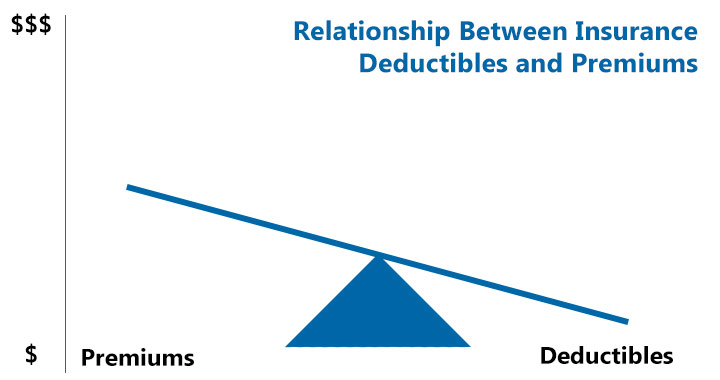Updated on June 15th, 2024.
What is an insurance deductible?
An insurance deductible is the amount of money you would pay in the event of an accident (assuming liability).
For example, a standard insurance policy may be $100 a month with a $1000 deductible. Meaning in the event of an accident, you would be responsible for $1000 and the rest is covered by your insurance policy.
This is to promote safe driving habits and spread the full cost of an accident across several parties (insurance company and insured motorists).
These two figures (the monthly premium and the deductible) often move in opposite directions.

The figure above demonstrates that if you choose a lower monthly payment (premium) your deductible goes up.
The opposite would be a higher monthly premium, which would result in a lower deductible. That’s because you are offering to take on more risk, by paying a larger share of the damage if an accident occurs.

There’s many variables to consider when deciding between a high or low deductible.
It’s a logical, financial and personal decision that determines what fits your needs best. Insurance policies are based on risk with each party in the agreement assuming some kind of risk. Insurance companies offer several policies to fit peoples needs with some policies requiring higher monthly dues and others higher payments in the event an insurance claim is submitted.
The policy that best fits your needs will depend on several factors including current financial obligations and even future cash flows.
Before you purchase an insurance contract, it is important to determine whether you will have enough money to cover all the costs associated with an accident.
- medical bills
- medical co-payments
- deductibles
- rental car fees
- etc.
Let’s break down the two most popular types of motor vehicle insurance. High and Low Deductible Insurance.
Choosing a Higher Insurance Deductible
Most people seek the advantage of a higher deductible because the monthly rate is lower. The risk of paying a higher deductible may be suitable for someone who:
- Doesn’t drive often
- Avoids driving long distances
- Avoids driving in large urban areas
- Avoids driving during peak hours
- Has a savings account with a comfortable balance for emergencies
In 2012 there were 5,419,000 police-reported motor vehicle traffic crashes. In 2021 there were 6,102,936 police-reported motor vehicle traffic crashes.
Most of which occured in large urband areas and metropolitan areas. This increases the likelihood of being in a car accident. That is why rural insurance policies are significantly less than urban insurance policies. Per the Association for Safe International Road Travel, Road Crashes in America cost $230.6 Billion per year.
A question to ask yourself is is ‘Will the money I save in auto insurance premiums be used for necessities that warrant taking on a higher deductible?’
Consider that an accident will already be a traumatic experience with the loss of time and money.
This a great policy for those who wish to be rewarded for safe driving habits and are willing to risk higher out of pocket expenses in the event of an accident.
Example policy is $100 monthly premium and a $2500 insurance deductible.
Choosing a Lower Insurance Deductible
Many people opt for a higher monthly insurance payment, but a lower deductible. This ultimately reduces your out of pocket expenses in the event of an accident.
This is great for younger drivers who may not have a lot of cash reserves or enough safe driving habits and experience.
Example policy is $200 monthly premiums and a $1500 deductible.
How to Choose Between a Lower Deductible or Higher Deductible Insurance Plan
Factors that should be taken in consideration at the end of the day should be plain and simple, and that’s your driving record and your current finances.
If you have a great driving record and you have more than 10 years, you can probably lower your collision deductible without much difference in your monthly rate.
The typical car insurance deductible increment choices are: $250, $500, $1,000, and $1,500.
If you’ve never been in an accident or even received a parking ticket, it’s within reason to deviate towards the higher deductible. If you have a reckless driving accident history then you obviously need to take the smarter route and get the lower deductible route. Again, adjusting your finances on a ‘maybe’ situation can be the major deciding aspect.
An additional thing to consider before buying car insurance is the amount of coverage you’d like.
You will pay more for higher coverage limits and for carrying optional coverage’s; however, these optional coverage may offer much-needed protection in case of an accident or other vehicle-related incident.
Liability insurance is typically a legal requirement; however, other coverage’s such as collision and comprehensive are generally optional, which cover the medical bills that may occur due to the accident.
Contact our Miami Auto Insurance Specialist today or visit the Insurance Industry Blog for more information.


